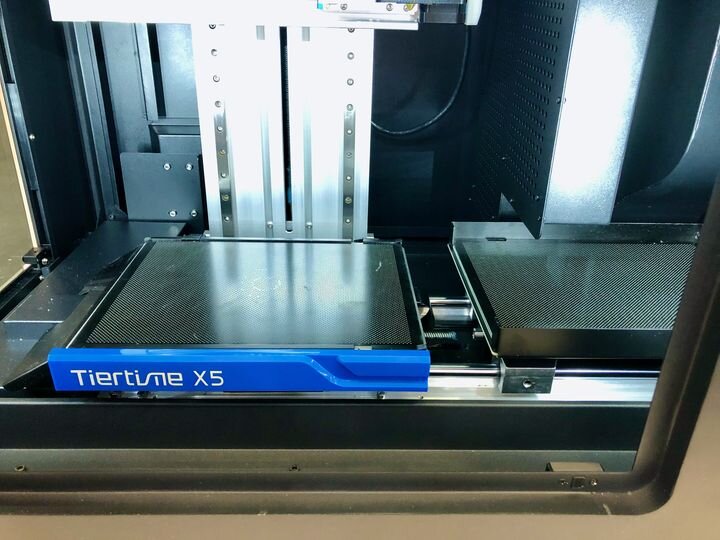![3D prints being made continuously [Source: Fabbaloo]](https://fabbaloo.com/wp-content/uploads/2020/05/continous-robotfactory-1_img_5eb05067ce40c.jpg)
One of the most fascinating features I’ve seen on 3D printers is the ability to self-unload completed 3D prints.
This is very different from typical 3D printers where at job termination, an operator must manually remove the completed 3D print and prep the machine for subsequent prints. While this is quite suitable for single prints, it’s an enormous challenge when multiple 3D prints are required.
Serial Production 3D Printing
If you had to produce, say, 100 items and you could fit only four on a build plate, you’d have 25 consecutive jobs to run. If these were to take, say, six hours to complete, you’re looking at 6 hours X 25 jobs = 150 hours of 3D printing.
But that’s entirely misleading because of the manual work requirement. The 3D printer stops and waits until the operator shows up to peel the print off the bed and resets it for the next job. In many cases, the next job must be started manually.
When, exactly, does this manual work take place? Is the operator sitting beside the machine waiting for job completion? In our 6-hour print example, the operator would have to be at the machine’s side at, say, midnight, 0600, 1200, 1800 and then repeat at midnight each day until all prints are complete.
That’s not a reasonable thing to do unless you happen to have 24-hour operator staffing. In most cases the midnight print would sit until the operator shows up in the morning, and the 1200 print would finish just after the staff left for the day. That means the midnight print would not get done and the 1200 print would sit until 0900 the next morning.
In other words, instead of getting four prints per day, you’d probably get only two due to the intermittent appearance of the operations staff, and the machine’s inability to unload it self and start the next job.
This problem has been solved by several companies.
![RobotFactory’s continuous 3D printer [Source: Fabbaloo]](https://fabbaloo.com/wp-content/uploads/2020/05/image-asset_img_5eb05067f3f00.jpg)
Multiple companies have developed belt-style 3D printers that can rotate the belt after printing and release prints into a bucket. BlackBelt, White Knight, PowerBelt3D, and RobotFactory all offer belt-driven 3D printers capable of continuous 3D printing.
![Tiertime’s X5 3D printer with automatically swapping build plates [Source: Fabbaloo]](https://fabbaloo.com/wp-content/uploads/2020/05/image-asset_img_5eb0506822f8e.jpg)
Tiertime also offers an unusual plating system on their X5 system that pushes out completed build plates and loads up a new, fresh build plate for subsequent 3D print jobs. The X5 holds up to 12 plates that would allow for quite a long period of unattended and continuous 3D printing.
Loop3D offered a system that used pins in the build plate to push completed prints off the surface automatically.
For a time, Stratasys also experimented with the concept, displaying a fascinating scalable continuous 3D printing system as a technology demonstrator.
But something happened. The Stratasys continuous build demonstrator disappeared. Loop3D abandoned their concept. And all the others, while still marketing their continuous 3D printing solutions, do not seem to have taken off.
There does not seem to be a big demand for continuous 3D printing.
Why? I have some ideas.
One thought is that it could be that most 3D printers are simply used as prototyping machines where single objects are produced. If this is the majority use, then there would be little demand for continuous 3D printing.
Another is that 3D print speeds might not be as important as we assume. While 3D printer manufacturers work hard to speed up their devices, if operators are willing to let the machine sit idle overnight, then why need the added speed?
It could also be that other factors outweigh the need for continuous 3D printing. If, for example, only 10% of the work on a device was to be continuous, why spend extra money on a device with that feature when you can get a cheaper device for the 90% of the work?
It may also be that the print quality on continuous devices may not be as high as other equipment, and buyers focus more on quality than continuous capabilities.
Or something else.
Whatever it is, it seems that continuous 3D printing has yet to be adopted.


One issue may be the changing requirements. Continuous may work well if you’re doing a lot of similar parts, continuously (but in that case, it’s still worthwhile to evaluate other approaches).
But for short run production, how many parts need the same setup? E.g. for FFF printers, filament type (PLA/PET/PETG/Nylon/PEEK/etc), filament variations (color, addons such as carbon fiber), support material (best choice varies with filament type), and build plate (again, best choice varies with filament type and desired surface finish (e.g. Prusa powder coated vs smooth PEI).
The continuous belt printers seem set up for continuous production of PLA parts in a standard color. The Tiertime approach could be more flexible, since you could load different types of build plates.
One issue may be the changing requirements. Continuous may work well if you’re doing a lot of similar parts, continuously (but in that case, it’s still worthwhile to evaluate other approaches).
But for short run production, how many parts need the same setup? E.g. for FFF printers, filament type (PLA/PET/PETG/Nylon/PEEK/etc), filament variations (color, addons such as carbon fiber), support material (best choice varies with filament type), and build plate (again, best choice varies with filament type and desired surface finish (e.g. Prusa powder coated vs smooth PEI).
The continuous belt printers seem set up for continuous production of PLA parts in a standard color. The Tiertime approach could be more flexible, since you could load different types of build plates.